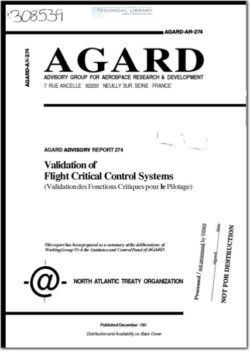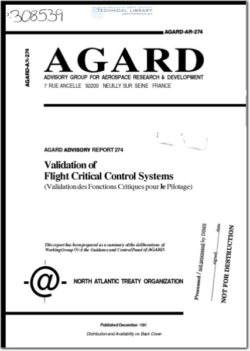AGARD-AR-274

- Version
- 276 Downloads
- 3.16 MB File Size
- 1 File Count
- March 8, 2016 Create Date
- March 8, 2016 Last Updated
Validation of Flight Critical Control Systems

Automation and digital electronic control systems are being used in ever increasing levels in aircraft flight
control systems. The benefits of these advanced control systems have been dramatic, contributing to major
improvements in aircraft performance and mission effectiveness. Full time digital fly-by—wire control
systems with active controls of unstable aircraft modes have reached the point of being essential to the
aircraft’s safe operation. The safety-critical nature of these modem flight control systems requires an
extremely high level of reliability and integrity, equivalent to that of the basic aircraft structure itself.
Although the first manned slpacecraft an'd earliest experimental aircraft digital fly-by-wire control systems
used single thread elements 1, today’s flight control systems employ extensive redundancy for any element
whose failure could jeopardize vehicle safety. Triplex or quadruplex redundancy is often used for sensors,
computers, actuators, and data communication links between them to provide continued operation in the
event of failures.
Control algorithms have grown in complexity as well, often involving several modes of control, with
complex gain scheduling and interfaces with various other aircraft systems and subsystems. Control laws
are used to provide artificial longitudinal stability where the aircraft’s stability margins have been relaxed
or designed to be negative to gain maneuvering or cruise performance advantages. In some aircraft, the
unaugmented divergence rate is so high, that total loss of the electronic flight controls would result in
vehicle dynamics which could compromise the crew’s ability to egress.
The multiple redundant systems and the so histicated control laws have resulted in a complex and time-
consuming design, developmcnt and quali ication process. Entire AGARD symposia and lecture series’
have been devoted to the design and development aspects of advanced flight control systemsp'sl. The
qualification process, however, has also grown to be a major critical activrty in the overall process of
achieving a safe and effective production flight control system, and has a technology aspect of its own.
This has bcen recognized in a recent AGARD Working Group effort addressing the verification and
validation of real time software for flight control systems.
| File | Action |
|---|---|
| AGARD-AR-274 Validation of Flight Critical Control Systems.pdf | Download |

Comment On This Post